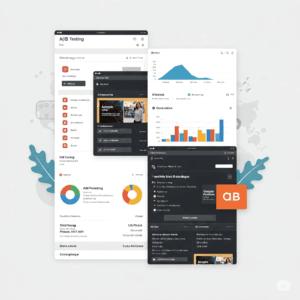A/B Testing in Google Ads: What to Test & How to Start
 If you’re running Google Ads and hoping to squeeze every last drop of performance from your campaigns, A/B testing isn’t just an option — it’s a necessity. But here’s the catch: A/B testing in Google Ads isn’t just about guessing which headline sounds cooler or which color button pops more. It’s about data-driven decisions, smart experimentation, and unlocking growth opportunities you didn’t even know existed.
If you’re running Google Ads and hoping to squeeze every last drop of performance from your campaigns, A/B testing isn’t just an option — it’s a necessity. But here’s the catch: A/B testing in Google Ads isn’t just about guessing which headline sounds cooler or which color button pops more. It’s about data-driven decisions, smart experimentation, and unlocking growth opportunities you didn’t even know existed.
Let’s cut through the noise and get straight to what really matters: What to test in your Google Ads campaigns and how to get started right now.
Why A/B Testing in Google Ads is a Game-Changer
Google Ads isn’t static — your audience, competitors, and market conditions are always shifting. A campaign that worked last month might tank today. That’s why A/B testing (also called split testing) lets you continuously refine and optimize your ads by running two versions and seeing which one performs better.
Think of it as the scientific method for digital marketing. Instead of relying on gut feelings or “best practices,” you let real-world data guide you. Brands like WordStream and Search Engine Journal consistently emphasize that structured A/B testing can boost click-through rates (CTR), lower cost-per-click (CPC), and ultimately increase your return on ad spend (ROAS).
What to Test in Google Ads: The High-Impact Elements
Not every element in your ad deserves a test. Some changes barely move the needle, while others can be the difference between a dud and a winner. Here’s what you should absolutely consider testing:
1. Ad Headlines
Your headline is the first thing people see — make it count. Test different value propositions, offers, or even emotional triggers. For example, “Get 50% Off Today” vs. “Save Big on Your First Order” could resonate differently depending on your audience.
2. Ad Descriptions
While headlines hook users, descriptions close the deal. Experiment with benefits, features, or urgency phrases. Should you highlight free shipping or fast delivery? Try different CTA styles like “Shop Now” vs. “Get Started.”
3. Display URLs
A subtle but surprisingly effective element. Sometimes showing a simplified or keyword-rich path (e.g., www.yoursite.com/Sale) can improve relevancy and CTR.
4. Call-to-Action (CTA) Buttons
If you’re running responsive ads or extensions with CTAs, test different verbs and placements. “Learn More,” “Buy Now,” or “Get a Quote” can dramatically influence clicks.
5. Ad Extensions
Extensions like site links, callouts, and structured snippets boost ad real estate and provide additional info. Test which combination or wording of extensions gets more engagement.
6. Audience Targeting
Test different audience segments — maybe your product resonates better with a younger crowd or a niche interest group. Experiment with demographics, in-market audiences, or remarketing lists.
7. Landing Pages
This is often overlooked but critical. Run ads pointing to different landing pages to see which layout, copy, or offer drives better conversions.
How to Start A/B Testing in Google Ads: A Step-by-Step Guide
You’re convinced testing is powerful. Great. Now, here’s the no-fluff roadmap to getting started:
Step 1: Pick One Variable to Test
Focus is everything. Testing too many things at once makes it impossible to know what actually caused the difference. Start with your ad headline or description — these are the biggest levers.
Step 2: Create Two (or More) Variations
Duplicate your ad and tweak the chosen element. Keep everything else constant. This controls the experiment and isolates the effect of the change.
Step 3: Set Up Your Experiment Properly
Google Ads lets you run experiments directly in the interface, splitting your traffic between the original and variant ad. Use the Google Ads Experiments tool to avoid bias and get reliable results.
Step 4: Run the Test Long Enough
Don’t rush. You need statistically significant data to make confident decisions. Depending on your traffic volume, this could be a week or a month. Tools like Google Ads’ built-in performance stats can help judge significance.
Step 5: Analyze the Results
Look beyond clicks. Consider CTR, conversion rate, CPC, and ROI. Sometimes a lower CTR ad converts better — that’s the real win.
Step 6: Implement Winning Variations and Iterate
Roll out the winner fully, then pick a new element to test. A/B testing is a continuous journey, not a one-time task.
Pro Tips From the Pros
Use Responsive Search Ads (RSAs): Google’s RSAs automatically test different combinations of headlines and descriptions to optimize performance, but you can still run manual A/B tests for more control.
Don’t neglect device performance: Sometimes ads perform differently on mobile vs desktop. Consider device-specific testing.
Document your tests: Keep a simple spreadsheet to track what you tested, dates, results, and learnings. This prevents repeating the same experiments and helps scale your optimization efforts.
Focus on conversions, not just clicks: Ultimately, you want to improve your bottom line, not vanity metrics.
Final Thoughts
A/B testing in Google Ads is like having a secret weapon in your marketing arsenal. When done right, it removes guesswork, cuts wasted spend, and uncovers new ways to grow your business.
Start small, keep it structured, and let the data lead the way. As Neil Patel says, “Test everything and never stop learning.” Your Google Ads campaigns will thank you.
